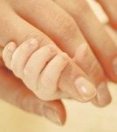including congenital myasthenia gravis, perinatal lethal Gaucher
disease, and Freeman-Shelton syndrome to name just a few. Some forms
affect nearly all of the major joints. Other forms of arthrogryposis may involve primarily the hands and feet
(distal arthrogryposis). The course and outcome of the
disorder will depend on the underlying cause of the arthrogryposis and normal
development of the lungs.
Amyoplasia (Arthrogryposis Multiplex Congenita) accounts for more
than 40% of children with arthrogryposis. Although these infants will
require orthopedic and rehabilitative interventions during their childhood,
their functional outcome in both physical and educational areas is excellent.
The condition is sporadic.
About one-third of children born with arthrogryposis have a severe or lethal
form of Pena-Shokeir phenotype or lethal multiple pterygium syndrome. These
infants usually do not survive past the neonatal period. Pena-Shokeir and lethal
multiple pterygium are often inherited as autosomal recessive traits.
Ultrasound findings may include increased amniotic fluid
level, decreased movement, knocked knees, clubfeet, and clubbed hands.
The risk of recurrence
is ~ 1% for sporadic cases, 25% if arthrogryposis is associated with an autosomal
recessive cause, 50% if inherited as an autosomal dominant trait, and 50% of
males will be affected if inherited as an X-linked recessive disorder. When the specific diagnosis is unknown, there is a 5 percent chance that
another child will be born with the same condition or that an affected adult
will have an affected child.

